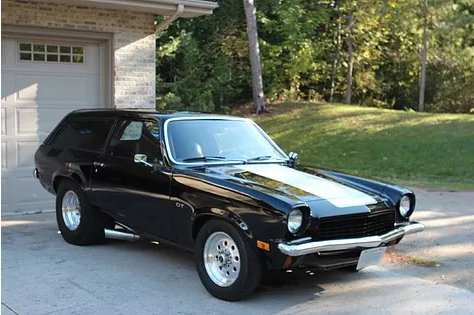The Berkeley automobile was a joint effort between designer Lawrence Bond and the Berkeley Coachworks factory owned by Charles Panter, which at the time was one of the largest manufacturers of travel trailers (caravans) in Europe. It was an ideal project for Berkeley, which had developed considerable skills in the use of glass reinforced plastic (GRP), and were looking for something to fill the gaps in the very seasonal caravan market. What they both wanted to achieve was “something good enough to win World 750cc races… but cheap, safe, easily repairable and pretty. Well, pretty is a good word for the design.
Pretty and small – length is just fractions over 10 feet! The design is so good that you can’t tell how small it is until you park beside something else. For perspective, the new Fiat 500 looks large beside the Berkeley.
The early cars were an immediate success in the UK market, and there were several models over the four years of car production. Export markets, like the United States, were developed and the cars earned a reputation for fun sports motoring on a budget. The newly introduced Mini and Austin-Healey Sprite in the late fifties, pushed the company to start to develop a more conventional model.
Just about then though, towards the end of 1960 the travel trailer market collapsed, and Berkeley’s assets – including its cars – were liquidated in 1961. The source of funds to carry on had dried up.
All told, about 4100 cars had been produced.
The B95 and B105 models were launched in 1959 and with more power from the 50 bhp Constellation motor, the B105 could now exceed the magic 100 mph (160 km/h).
The prototype car was modified to add bracing to withstand the extra power and weight of a four-stroke engine, and a taller hood with large grille to accommodate the engine. The new front- end design became quite distinctive and aggressively attractive.
However, essentially, the car was built with 3 tubs bolted together at the bulkheads.
Bob wasn’t overly concerned about the structure until he was measuring the car for a new top and tonneu and when sitting in the car the measurements changed – meaning there was considerable flexing with the tub-no-frame design. That wasn’t comforting to Bob who has built and raced a number of Formula 4 cars and modified a few other types – including this little Berkeley that would now easily accelerate to over 160 km/hr. With that in mind, it is easy to see why Bob added support to stiffen up the basic structure. The 3 fibreglass tubs bolted together wasn’t confidence inspiring!
Now the car is considerably stiffer with the tubular frame and the stronger wheels which Bob also fabricated.
When comparing the 1956 version with its 15 hp to Bob’s car, below the surface, there is very little “stock” Berkeley remaining. His Kawasaki 4 will crank out 100 hp and rev up to over 10,600 rpm. His conversion includes a six speed sequential transmission with electric reverse.
Back when these cars came out, Bob was intrigued but in those days the $1800 price was just out of reach. That would be roughly equivalent to $14,000 today and just starting out Bob didn’t yet have that much cash to spend on a car. So he had to wait a bit and knew about this one which had been in boxes for 20 years waiting for restoration – just the sort of challenge typical for Bob – he could now improve the original design shortcomings and end up with something to enjoy at speed!
This car weighs about 800 lbs – driver extra– so the power to weight ratio allows it to be quite quick! Berkeleys were always impressive as racers even with the small engines and it handles the corners like it is on rails!
He winces a bit about the Diamond White paint job which cost him 3 times the cars’ 1960 price tag.
The new windshield took some time to arrive from England but it was not just sitting on-the-shelf waiting for Bob to order it! Even though the original pattern was still available at Pilkington Glass, it took a while for it to be made and shipped – prepaid of course. Being such a “one-off” item, it was a nervous many months spent waiting and hoping it would arrive in one piece! But it handled the trip from England and was a perfect fit.
The new top and windows recently added are a great addition and custom made, they follow the original design which gives good visibility while driving. In fact this car is so small – the top up position makes the car more visible to other drivers as well!

Photos by Chris Haley, London, Ontario







































